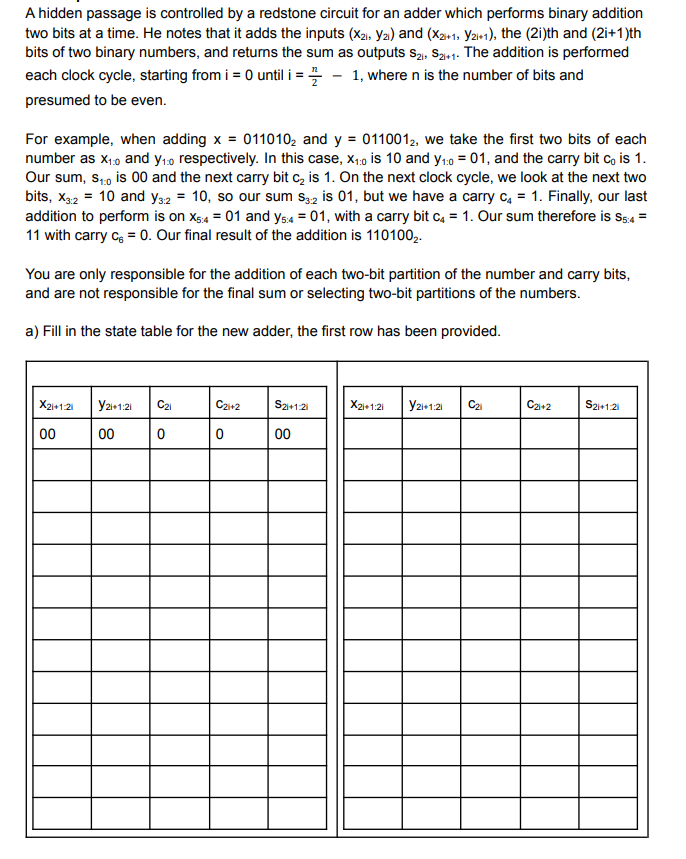A hidden passage is controlled by a redstone circuit for an adder which performs binary addition two bits at a time. He notes that it adds the inputs (X2, ya) and (X2-1, Ya+1), the (2i)th and (2i+1)th bits of two binary numbers, and returms the sum as outputs s2, Sas1. The addition is performed each clock cycle, starting from i = 0 until i == - 1, wheren is the number of bits and presumed to be even. For example, when adding x = 0110102 and y = 0110012, we take the first two bits of each number as x1,9 and y;,9 respectively. In this case, x1,9 is 10 and y:0 = 01, and the carry bit c, is 1. Our sum, s0 is 00 and the next carry bit c, is 1. On the next clock cycle, we look at the next two bits, X32 = 10 and y32 = 10, so our sum s32 is 01, but we have a carry c, = 1. Finally, our last addition to perform is on xs4 = 01 and ys4 = 01, with a carry bit c, = 1. Our sum therefore is ss.4 = 11 with carry cg = 0. Our final result of the addition is 110100. You are only responsible for the addition of each two-bit partition of the number and carry bits, and are not responsible for the final sum or selecting two-bit partitions of the numbers. a) Fill in the state table for the new adder, the first row has been provided.
A hidden passage is controlled by a redstone circuit for an adder which performs binary addition two bits at a time. He notes that it adds the inputs (X2, ya) and (X2-1, Ya+1), the (2i)th and (2i+1)th bits of two binary numbers, and returms the sum as outputs s2, Sas1. The addition is performed each clock cycle, starting from i = 0 until i == - 1, wheren is the number of bits and presumed to be even. For example, when adding x = 0110102 and y = 0110012, we take the first two bits of each number as x1,9 and y;,9 respectively. In this case, x1,9 is 10 and y:0 = 01, and the carry bit c, is 1. Our sum, s0 is 00 and the next carry bit c, is 1. On the next clock cycle, we look at the next two bits, X32 = 10 and y32 = 10, so our sum s32 is 01, but we have a carry c, = 1. Finally, our last addition to perform is on xs4 = 01 and ys4 = 01, with a carry bit c, = 1. Our sum therefore is ss.4 = 11 with carry cg = 0. Our final result of the addition is 110100. You are only responsible for the addition of each two-bit partition of the number and carry bits, and are not responsible for the final sum or selecting two-bit partitions of the numbers. a) Fill in the state table for the new adder, the first row has been provided.
Chapter4: Processor Technology And Architecture
Section: Chapter Questions
Problem 9VE
Related questions
Question
Help me please

Transcribed Image Text:A hidden passage is controlled by a redstone circuit for an adder which performs binary addition
two bits at a time. He notes that it adds the inputs (x2, ya) and (X2+1, Yar1), the (2i)th and (2i+1)th
bits of two binary numbers, and returns the sum as outputs są, Sa.1. The addition is performed
each clock cycle, starting from i = 0 until i = = - 1, wheren is the number of bits and
presumed to be even.
For example, when adding x = 011010, and y = 0110012, we take the first two bits of each
number as x1,0 and y1,0 respectively. In this case, x1,0 is 10 and y1,0 = 01, and the carry bit co is 1.
Our sum, s10 is 00 and the next carry bit c, is 1. On the next clock cycle, we look at the next two
bits, X32 = 10 and y32 = 10, so our sum s32 is 01, but we have a carry c, = 1. Finally, our last
addition to perform is on xs4 = 01 and ys:4 = 01, with a carry bit c4 = 1. Our sum therefore is sg.4 =
11 with carry c = 0. Our final result of the addition is 1101002.
You are only responsible for the addition of each two-bit partition of the number and carry bits,
and are not responsible for the final sum or selecting two-bit partitions of the numbers.
a) Fill in the state table for the new adder, the first row has been provided.
X21+121
Y2+1.21
C21
C2i+2
S2+121
X21+1:21
Y2ı+1:21
Ca+2
S2+12
00
00
00

Transcribed Image Text:b) Draw a schematic design using a D flip-flop, two Full Adders, and a minimal network of AND,
OR, and NOT gates. You only need to draw the schematic for the addition of the given two bits
(do not be concerned how the next set of bits would be selected or passed into this circuit.)
Expert Solution
This question has been solved!
Explore an expertly crafted, step-by-step solution for a thorough understanding of key concepts.
This is a popular solution!
Trending now
This is a popular solution!
Step by step
Solved in 3 steps with 2 images

Knowledge Booster
Learn more about
Need a deep-dive on the concept behind this application? Look no further. Learn more about this topic, computer-science and related others by exploring similar questions and additional content below.Recommended textbooks for you

Systems Architecture
Computer Science
ISBN:
9781305080195
Author:
Stephen D. Burd
Publisher:
Cengage Learning

Systems Architecture
Computer Science
ISBN:
9781305080195
Author:
Stephen D. Burd
Publisher:
Cengage Learning